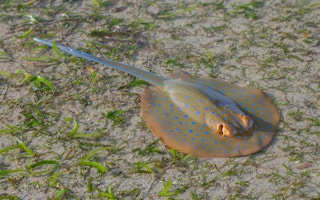Seagrass meadows are the fishing grounds of choice for many households in four Indo-Pacific countries, according to a new study that calls for better-informed management of these often-overlooked marine habitats.
It found that small-scale fishers in 147 coastal villages in four tropical countries — Cambodia, Tanzania, Sri Lanka and Indonesia — rely primarily on seagrass meadows, saying these habitats are reliable, suitable, familiar, and accessible. The study, published in June in the journal Ocean & Coastal Management, noted that this finding should prompt a rethink of general perceptions of small-scale fisheries.
“Nearly half of all households we talked to preferred fishing in seagrass over other habitats such as coral, mangroves, open ocean, mud and rock for example,” lead author Benjamin Jones, a doctoral candidate in the department of ecology environment and plant sciences at Stockholm University, said in a statement.
“This was surprising because most people think of reef fisheries as the key tropical small-scale fishery, but we show that its actually engagement in seagrass fisheries that are much more characteristic of households,” Jones added.
“
People use and value seagrass for many different reasons, so safeguarding seagrass is vital to ensure that all people, all of the time, have equitable and equal access to the resources seagrass provides.
Leanne Cullen-Unsworth, director of research, Project Seagrass
Jones and his colleagues analyzed interviews with 1,105 households conducted between 2012 and 2017, where 869 identified as fishers, in areas where both seagrass meadows and coral reefs were present. They found that nearly two-thirds of the fishers used seagrass meadows the most as their fishing ground, either exclusively or as part of multiple options. This was followed by coral reefs, substrates like mud and sand, and deep-water areas, the research found.
The preference for seagrass meadows, they found, included expectations of a big catch and greater fish availability. Many fishers also identified seagrass meadows as being more easily accessible than coral reefs, often without the need for a boat, and less likely to damage equipment such as nets.
The study also found that household income strongly influenced the reliance of fishing households on seagrass meadows. Seagrasses provide resources for those who can’t afford to own motorboats and those who use static fishing fences.
Seagrasses are underwater flowering plants, not to be confused with seaweed, that grow in shallow coastal waters, providing a crucial nursery habitat for young fish of many species. They’re also an important home for marine invertebrates, like sea cucumbers, crabs and prawns. Many experts suggest that a healthy coastal ecosystem with seagrass, mangrove and coral reef habitats can store large quantities of carbon dioxide, filter sediment and debris washing in from the land, and protect against coastal abrasion.
However, seagrass meadows around the world are disappearing at rates that rival those of coral reefs and tropical rainforests, losing as much as 7 per cent of their area each year, according to the IUCN, the global plant and animal conservation authority. Climate change, coastal development, pollution, and the spread of invasive species are some of the top threats to seagrass beds.
Jones and colleagues say their study emphasises the need for more empirical household-scale data to inform better management of seagrass meadows. Protecting these habitats, in turn, will ensure their sustainability for the marine life and people who depend on them.
“People use and value seagrass for many different reasons, so safeguarding seagrass is vital to ensure that all people, all of the time, have equitable and equal access to the resources seagrass provides,” said study co-author Leanne Cullen-Unsworth, director of research at conservation organisation Project Seagrass.
This story was published with permission from Mongabay.com.










